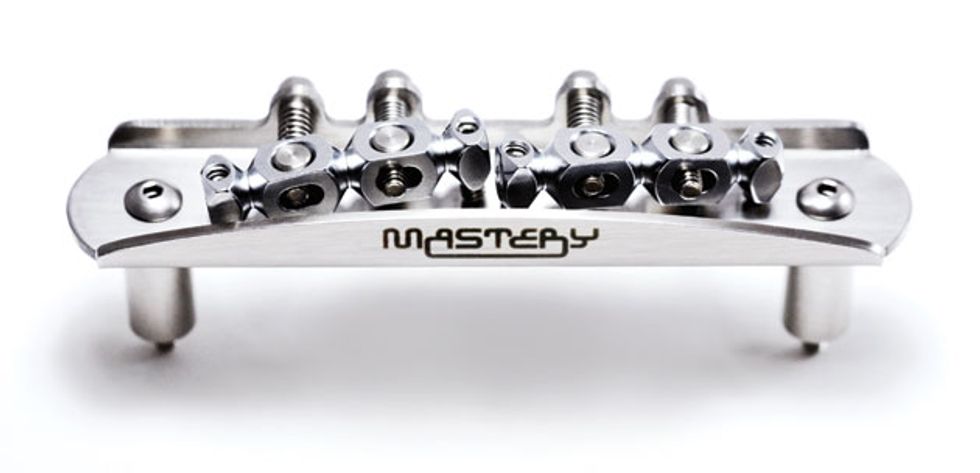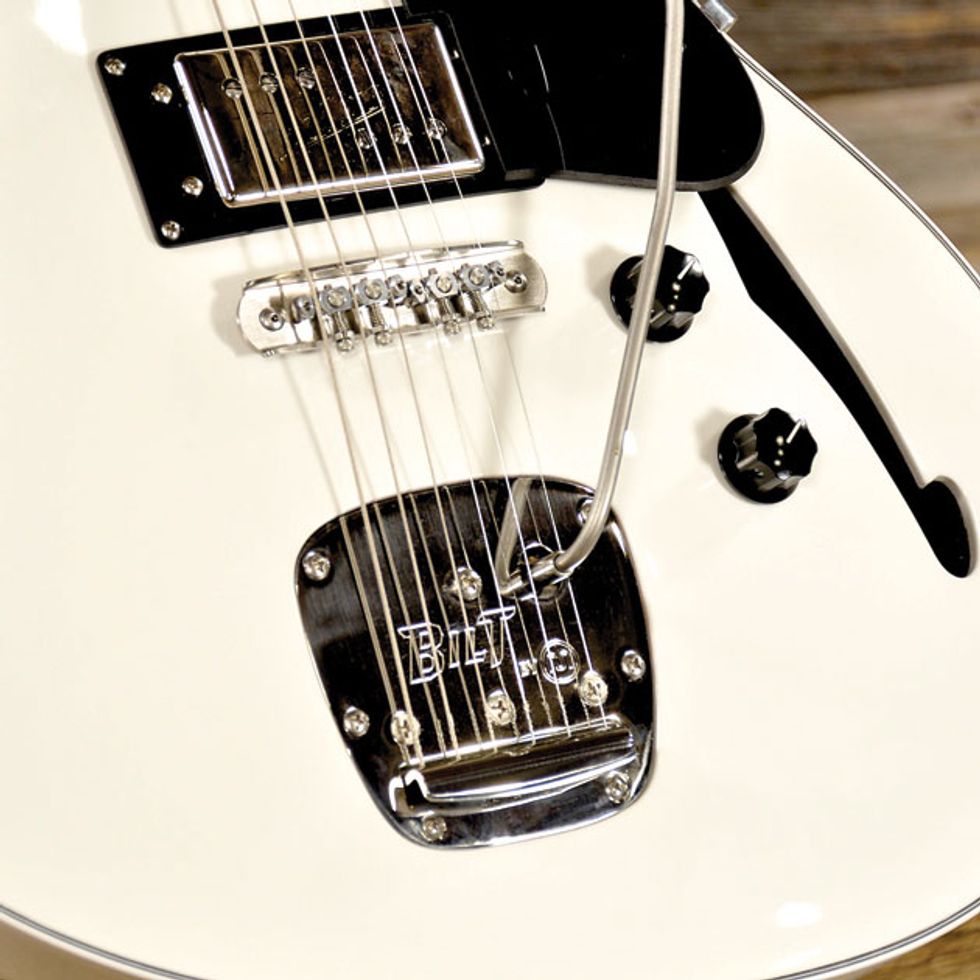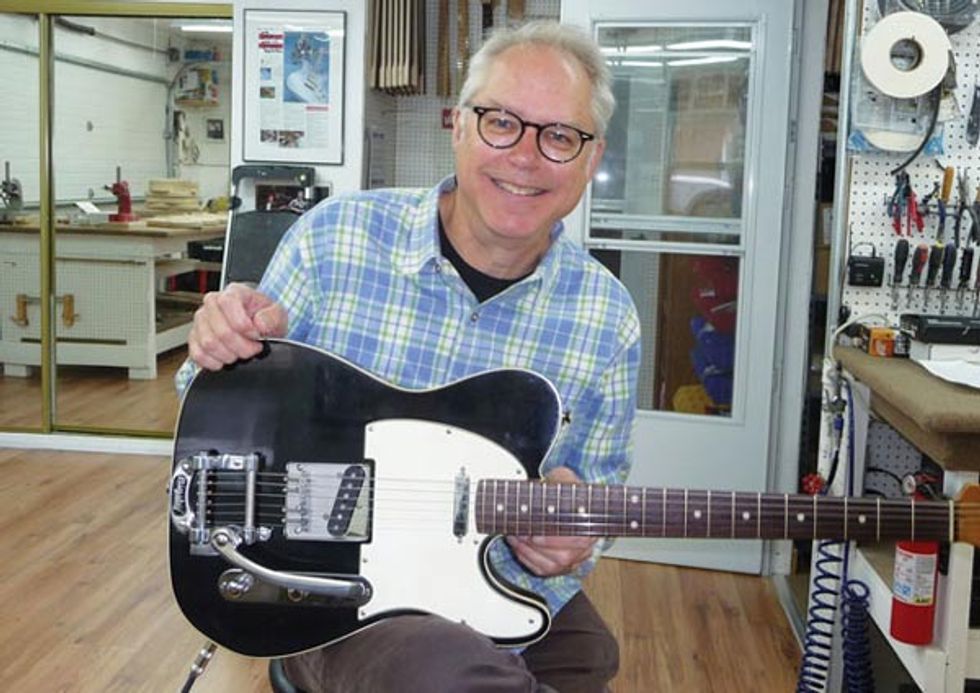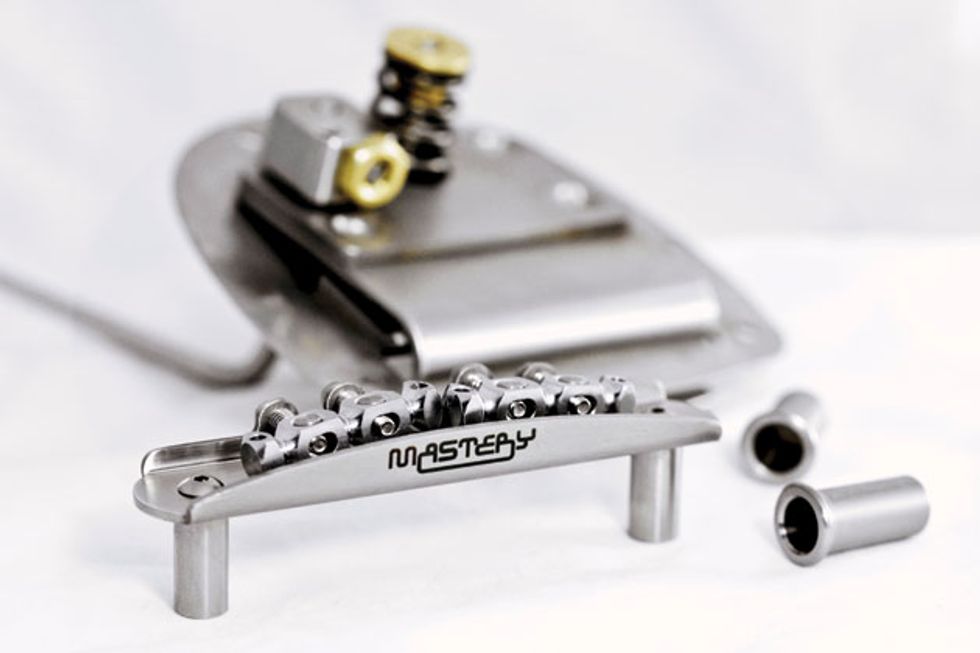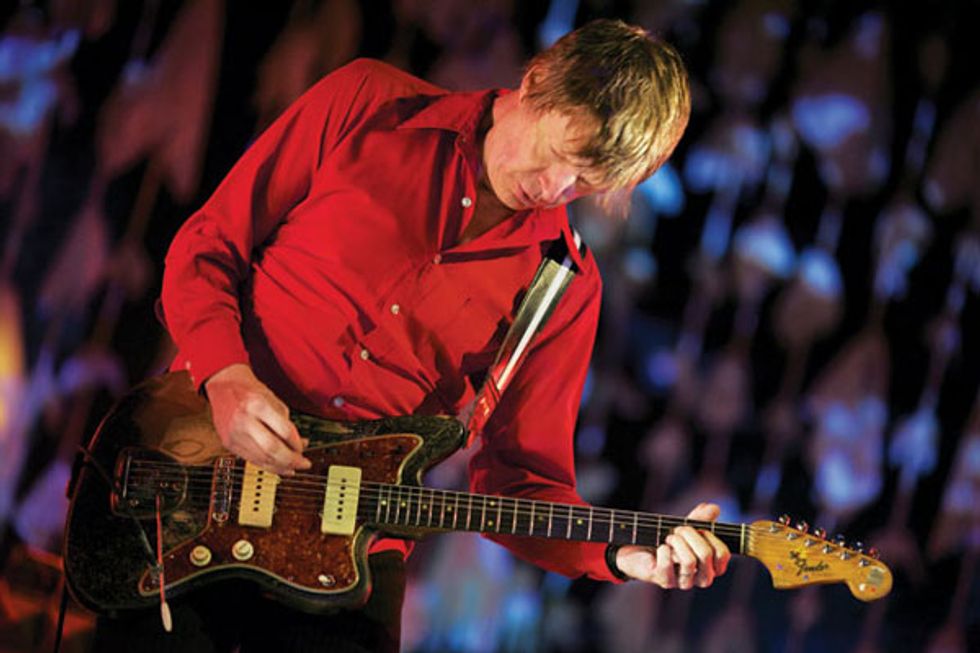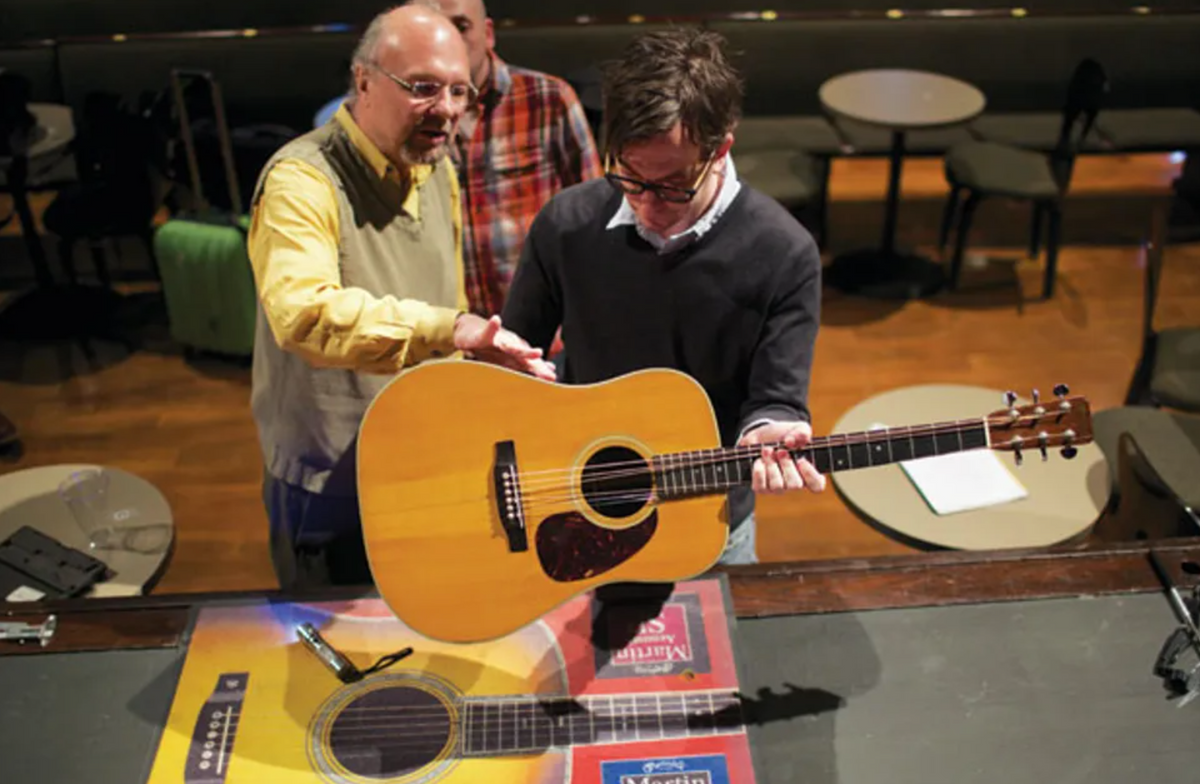
John Woodland inspects John Lennon's 1962 Martin D-28, the guitar Lennon used all throughout the 1970s
and on his last live performance.
Leo Fender didn’t get everything right the first time: How John Woodland perfected the offset guitar bridge.
Leo Fender designed the Jazzmaster in 1958, and for 50 years musicians fell in love with its elegant shape and unique sound—and fell out of love with its temperamental and fickle bridge. A luthier and designer named John Woodland put in a lot of time thinking about this problem—and a lot of time trying to fix those challenging bridges. In 2008 he had a flash of brilliance. The result of that flash was the Mastery Bridge.
The Mastery Bridge seems to be everywhere now. It's on new and vintage instruments played by Nels Cline, Bill Frisell, Elvis Costello, Sean Lennon, Troy Van Leeuwen, Thurston Moore, Lee Ranaldo, and many others, and on boutique guitars from BilT, Fano, and others. “Before John," says BilT's Tim Thelen, “the best anybody could do was to use a modified Mustang bridge. If there was no Mastery Bridge, there would be no BilT guitars."
I met John, a recognized expert on the history of the American guitar, when I was researching an article about the pre-war Martin D-45 [“Pre-War Perfection," June 2014]. There was so much historical material to cover then that we didn't have time to talk about the accomplishment for which he is so well known among Jazzmaster and Jaguar players. But several months ago, between designing and prototyping the new Mastery Vibrato, John spoke with PG about Mastery Bridge and his life in music and lutherie.
How did it all start?
I'd been running the repair shop at Willie's Guitars in Saint Paul for 10 years, and had been working on the guitars of some very well known musicians who used Jazzmaster and Jaguar guitars. I did all the known mods to get the bridges to work, but when the guitars came back from tours, the tweaks were failing and the guitars were falling apart. I was frustrated by that and sick of maintaining the classic bridges—I wanted something bulletproof. One day I had a moment of clarity and quickly drew out a design for a two-saddle adjustable bridge with four intonation screws and posts that fit snugly in the diameter of the existing thimbles.
I'd known Jeff Tweedy a long time, but I didn't know [fellow Wilco guitarist] Nels Cline. One day Nels came in and we connected. I had a prototype of my new bridge design sitting on the bench. The saddles weren't even plated—they were plain brass. I took his Jazzmaster to the bench and leveled and crowned the frets, did some other adjustments, and put my bridge on. He was playing at the Dakota Jazz Club in Saint Paul with the Nels Cline Singers that night. I watched them play, biting my nails the whole time. At the end of the show Nels said, “I'd like to thank John Woodland, because what he did for my guitar today is incredible."
The Mastery Bridge uses four height-adjustment screws rather than 12, and fits Fender Jazzmasters and Jaguars
without body modifications.
Was that his famous '59 Jazzmaster?
It was a different vintage guitar he was using for that tour. Nels has around 15 Jazzmasters, I think. The famous “Watt" guitar [Cline purchased it from bassist Mike Watt] is actually a 1960 Jazzmaster, but so many people think it's a '59 that it just keeps getting referred to that way. Back then Nels and I were just getting to know each other, so I didn't work on Watt right away. After he'd been using the Mastery Bridge for a while, Nels told Sonic Youth about the bridge, and they started trying them too. I was experimenting with different materials and going through a product development stage for about eight months. At some point Nels turned Bill Frisell on to them. After that, Nels came to me and said, “You have to make this available to people." Until then, I had no plans to market the bridge. I just wanted a better solution for my own clients. Nels was the first professional musician to use it, though.
BilT Guitars, based in Des Moines, Iowa, was the first builder to use the Mastery Bridge as original equipment hardware. Shown here is a Volare model. Photo courtesy of Chicago Music Exchange.
It sounds like you completely redesigned the classic Jazzmaster bridge.
There's a difference between redesign and design. I think most people try to improve on existing designs by taking prior art and making it the best it can possibly be: That's redesign. Design is different. It involves looking at a problem in an entirely new way, and Mastery Bridge is just that. When I do a design, I want as few parts on the guitar as possible, and I want those few parts to do a lot of things. I look for a simple and meaningful solution. For instance, our four saddle-height adjustment screws do what other bridges use 12 screws for. For five decades, those bridges have frustrated Jaguar and Jazzmaster players—it was not a new issue at all. The classic design was based on the idea that a rocking bridge would be an advantage, but it caused more problems for most players. I didn't want the bridge to rock. The design had to work on all offset guitars without drilling or modifying the guitar's body. After a lot of experimenting, I got prototypes to where I liked them enough to send them on tour with Wilco and Sonic Youth. They beat the hell out of them, but it worked—the guitars came back stable, like how I left them. A high school friend put up a website, but we didn't run any ads at all. It just exploded. We couldn't keep up with the demand.
Mastery Bridges have unusual chrome plating. It looks great, but is it more than cosmetic?
I chose a hard chrome plating that is usually used only in industries that require extremely hard plated surfaces, like aircraft landing gear and piston linings. When a player uses the vibrato a lot, the movement of the strings causes friction, and the resulting heat makes the guitar go out of tune. The very hard plating on our saddles is self-lubricating and helps to guide the string over the saddle without generating a lot of friction and heat.
Bill Frisell on Mastery Bridges
Bill Frisell with his current main guitar: a JW Black tele with a Bigsby Vibrato and a Mastery Bridge.
“I learned to play on a Fender Jaguar, so I have a soft spot for those guitars, but they are notoriously difficult to get to where things aren't falling apart. The original bridge design had so many little moving parts, little screws, and little Allen screws, right where the bridge is transferring energy to the body of the guitar, and the bridge balances on just two posts. There were so many places things could rattle and fall off, and the strings could slide off the side of the bridge. It was so temperamental! So when Nels Cline showed me the Mastery Bridge on his Jazzmaster, that totally took care of the whole deal, and in such a simple way. The fewer saddles you have, the more tension you get transferred to the body. The design has only two saddles, and they're uniquely adjustable. When Woody [John Woodland] designed a bridge that works with a Bigsby Vibrato, Jay Black [of JW Black Guitars] got excited and built me a tele custom with Woody's bridge and a Bigsby. That's basically the only guitar I've been playing lately." —Bill Frisell
You said that one day you had an inspiration and drew the design for the Mastery Bridge in a few minutes. What kind of previous experiences enabled you to do that?
My mother, grandfather, uncles, and cousins all played country music from the '40s and early '50s— Roy Acuff to early Carl Smith stuff. My grandmother played organ. My grandfather played mandolin and banjo. He played behind his back, like a vaudeville artist. So my first exposure to music was in my own family. I got my first guitar when I was 4. I took lessons when I was 5. When I was 13 or so, I started taking more serious interest in music. I had a Lotus Les Paul copy, and later my cousin, who was playing with Badfinger, gave me a nice handmade tele. One day the only other kid in my high school who played guitar was at my house, and he took the whole guitar apart when I wasn't looking. I think he thought it would be good for me to learn about it—some kind of Zen thing. Anyway, I was forced to figure out how to put it back together again and I did. That probably started my interest in working on instruments.
After high school I went to lutherie school in Red Wing, Minnesota, and after that I worked for Roger Benedict for four years in Minneapolis. We built a lot of guitars together. He used to say, “Perfection is in your own eyes. It's your idea of what the guitar should be like and look like," and he emphasized the importance of doing all the steps necessary to achieve that level of perfection. After Roger died, I worked as the tech for Soul Asylum for a couple of years, which was essentially just adult day care, so I didn't care for it much. I left and started the repair department at Willie's. I actually drew out the initial Mastery Bridge design there, and my coworkers were the first to see it. The working name was “Bridget," so after about six months of us all calling it Bridget I walked into the store one day and said, “I have a new name: Mastery Bridge." They hated it, so I figured it would work.
The Mastery M1-V kit solves the tuning and stability problems associated with classic Jazzmasters and Jaguars.
How did you get interested in the history of the American guitar?
My mother was a nurse, and she ran a home for elderly people. The old people would talk with me about their lives and experiences, and then they would die. It was like the people were gone, and their stories were gone too. It seemed their legacy was somehow lost on me as a 12 year old, not to be heard again. I think that's the core reason I obsessively sought out everything I could find about Paul Bigsby and John Deichman, and why I wanted people to know about what they did for the guitar community. Bigsby was hugely important. Everybody knows about the Bigsby Vibrato, but many people don't know he was the first to do the six-in-line Kluson tuner. Bigsby took the bass side of two sets of the then-new, closed-back tuners and ground down the mounting side so each screw would hold two sets of tuners. Had he not done that and used the whole tuner, it would have changed the top angle of the headstock. That's an example of a very small innovation that affected so much of the guitar world. Fender obviously took this—and never credited him. Spec'ing out the Merle Travis Bigsby and doing all the tracings was one of the most exciting things I've ever done, guitar-wise. It's the first modern electric guitar. When we were working on the Bigsby book [Andy Babiuk's The Story of Paul A. Bigsby: The Father of the Modern Electric Solidbody], I insisted on going to the Country Music Hall of Fame to go over it. It took some work to set that up—the glass case alone is so massive that it took four people just to open it up.
What about your interest in the history of the dreadnought?
I got interested because it was the most influential acoustic guitar design in the world, and no one really knew of its origin. Dick Boak [of Martin Guitars] told me that there were a bunch of papers locked in the attic of North Street Martin building. I climbed up there and found thousands and thousands of documents that had not been opened since the 1920s and '30s. It was unbelievable! I was pulling months-long chains of letters from people like Jimmie Rodgers that no one had seen since they were written. Each document I found led to 10 more questions, and eventually to the story of John Deichman, the man who actually drafted the dreadnought. My focus started with Martin and with the guitar itself, and then it became more about Deichman the man. Lots of people want to know about the bracing patterns, truss rods, and top thicknesses of these guitars. I'd spent my whole life repairing and building instruments—that part wasn't as interesting to me. For me, the way to understand the guitars was to understand the people who made them.How they looked to things. Their work ethic. Their perspectives on life. All that research also taught me that I needed to leave my own stamp in the community, another reason Mastery Bridge probably happened.
Nels Cline on John Woodland
Nels Cline (Wilco, the Nels Cline Singers) installed a Mastery Bridge on his most precious guitar: a 1960 Jazzmaster purchased from bassist Mike Watt and nicknamed “Watt."
“I was breaking things all the time on my 'Watt' guitar. Mastery Bridge saved my life. Another luthier—a very good one—had advised me to retire the guitar. The rosewood on the fretboard was so worn that it was scalloped in places, and he said that one more refret would be its last. John had asked me to send it to him, but I kept putting it off because I was nervous about shipping it. When I finally did send it, John said, 'This guitar has plenty of refrets left—go play it.' [Woodland used rosewood dust to fill the hollows in the fretboard.] John is the best. He can make everything perfect. He knows about these guitars, loves them, and has respect for me and my music." —Nels Cline
What projects are you involved in now?
The Mastery Vibrato was just released. I worked on the design for a year, and when we released it we thought we had enough stock for two months, but it sold out in one day. My goal is to grow Mastery Bridge slowly and to keep it manageable. I like to be hands-on, so I don't want it to be a huge operation. Right now we're looking at a somewhat bigger space so we can do more things. I'm also working on another part of the guitar. It'll probably take over a year to get it where I like it, but I think it's going to be amazing. I might build a few guitars in my garage, but for now Mastery Bridge is my focus. I feel a responsibility to do what I can to improve the guitar and to help guitar players progress. That's why I designed the FSC Jeff Tweedy OO Martin Guitar. I thought it was important to show that a guitar can be built of sustainable woods and still sound and look great. I'm working on a project with Sean Lennon and Martin Guitars right now. It's going to be the most important artist model guitar that I'll ever design. It's going to be amazing!
- Thurston Moore: Free Noise | Premier Guitar ›
- Tools for the Task: Tele-Style Bridges | Premier Guitar ›
- No-Brainer Mods 2019! | Premier Guitar ›
- Mastery Bridge Unveils New Bridge for JMs and Mustangs - Premier ... ›
- Why Do So Many Posers Play “Offset” Guitars? - Premier Guitar ›
- BilT Guitars Rele Offset Guitar with Fuzz Circuit Demo! - Premier Guitar ›
